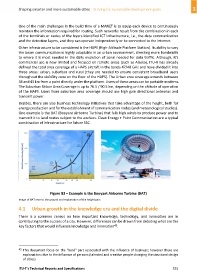Page 335 - Shaping smarter and more sustainable cities - Striving for sustainable development goals
P. 335
One of the main challenges in the build time of a MANET is to equip each device to continuously
maintain the information required for routing. Such networks result from the combination in each
of the terminals or nodes of the layers identified ICT infrastructure, i.e., the data communication
and the detection layers, and they can operate independently or be connected to the Internet.
Other infrastructure to be considered is the HAPS (High‐Altitude Platform Station). Its ability to vary
the beam communication is highly adaptable in an urban environment, directing more bandwidth
to where it is most needed in the daily evolution of zonal needed for data traffic. Although, it's
commercial use is now limited and focused on remote areas (such as Alaska), ITU‐R has already
defined the total area coverage of a HAPS aircraft in the bands 47/48 GHz and have divided it into
three areas: urban, suburban and rural (they are needed to ensure consistent broadband users
throughout the visibility zone on the floor of the HAPS). The Urban area coverage extends between
36 and 43 km from a point directly under the platform. Users of these areas can be portable modems.
The Suburban Urban Area Coverage is up to 76.5 / 90.5 km, depending on the altitude of operation
of the HAPS. Users from suburban area coverage should use high gain directional antennas and
transmit power.
Besides, there are also business technology initiatives that take advantage of the height, both for
energy production and for the establishment of communication nodes (and meteorological studies).
One example is the BAT (Bouyant Airborne Turbine) that fails high winds to produce power and to
transmit it to land routes subject to the anchors. Clean Energy + Point Communication are a typical
combination of infrastructure for future SSC.
Figure 83 – Example is the Bouyant Airborne Turbine (BAT)
Image of BAT near to the ground and explanation of the height gain
4.1 Urban growth in the knowledge era and the digital divide
There is a common census on how important knowledge, technology, and innovation are in
contributing to the success of a city. However, differences can be drawn from debating what are the
45
key factors that would influence knowledge and innovation .
____________________
45 This document focus on the "hard" part associated with the influence of business; however there are
explanations due to the influence of persons (talented and creative people changing the structural design
of cities).
ITU‐T's Technical Reports and Specifications 325

